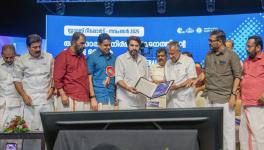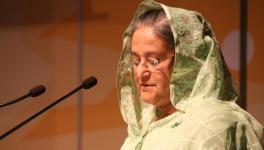There’s a Massive Humanitarian Crisis Unfolding in Asia: The Plight of the Rohingya

Image Courtesy: Hafiz Johari / Shutterstock.com
Relief workers for International agencies sit with me in Dhaka (Bangladesh). They are talking about the difficulties faced by the Rohingya people who have fled Myanmar for Bangladesh over the past several months. Over 650,000 people from the Rohingya community came into Bangladesh since August 25 of last year. This is a torrent of desperate people, a community threatened with extinction for the past seven decades. The refugee camps near Cox’s Bazaar are overcrowded and dangerously unhygienic. Already there is an outbreak of diphtheria, with indications of severe health challenges to come. According to the World Health Organisation, half of the refugees are malnourished and anaemic, while a quarter of the children suffer from acute malnutrition. A logistical worker for a relief agency tells me that in his three decades in this work he has never seen anything like this.
Matters are worse in Thailand, where an unknown number of Rohingya refugees have been sold into slavery (estimates suggest that 500,000 slaves work in various industries in Thailand). Many of those sold into slavery work on fishing boats, particularly in the prawn fishing industry. It is said that the price of the enslaved person now is a mere 5% of what it was in the 19th century. Indeed, the slavery does not begin when the refugees leave Myanmar. UN officials report that in the encampments where the Rohingya have gathered in Sittwe, the port city capital of Rakhine state inside Myanmar, ‘people smugglers are very active in the camps.’
Stunningly, it is now said that a quarter of the Rohingya people have been ejected from Myanmar, with large numbers internally displaced in what amount to concentration camps. Marixie Mercado of UNICEF visited some of these camps, even the ones that are hard to reach such as Pautaw township. ‘The first thing you notice when you reach the camps is the stomach-churning stench,’ Mercado recalls. ‘Parts of the camps are literally cesspools. Shelters teeter on stilts above garbage and excrement. Children walk barefoot through the muck. One camp manager reported four deaths among children ages 3 to 10 within the first 18 days of December.’ There are about 60,000 children in these camps, totally isolated and with ‘high levels of toxic fear,’ said Mercado.
Why this is happening
On September 19 of last year, Myanmar’s civilian leader and Nobel Peace Prize recipient Aung San Suu Kyi broke her silence about the atrocities against the Rohingya people. But her speech was filled with evasions of all kinds. She did not say the name Rohingya, afraid that its utterance would somehow give legitimacy to this community’s claim to being part of Myanmar’s social fabric. She said, oddly, that her government did not know exactly what was going on in Myanmar, that she would need to ‘find out why this is happening.’
But what is happening has been clear to Myanmar’s military and its civilian authorities for seven decades. There has been a careful campaign to ensure that the Rohingya, who live in northern Rakhine (previously Arakan) State, are firstly denied citizenship and then denied the ability to make a living. Massacres have been punctual, with the intensity having escalated since the 2012 pogrom. Aung San Suu Kyi would perhaps be best informed of the character of the violence if she visited the village of Yan Thei, where on October 23, 2012, the police and the Rakhine extremists colluded to destroy the village. In the melee, the extremists and the police took the lives of 28 children, 13 under the age of five, most of them hacked to death.
It is not enough to blame the extremist Buddhist monks and the Rakhine militants for this violence. The Myanmar state has been complicit in this violence from its inception. It has, for reasons of bigotry and religion, targeted the one minority group (the Rohingyas) that had not armed itself to fight for its right as a minority group (unlike the Karen and Shan peoples). The military and the civilian elite, including Aung San Suu Kyi, have used the defencelessness of the Rohingya as a way to define their nationalism. They have recently used the West’s War on Terror rhetoric to target this Muslim community.
The party of Aung San Suu Kyi, the National League for Democracy (NLD), has closely collaborated with the extremist groups from Rakhine State since the 1980s. While the NLD and Aung San Suu Kyi positioned themselves internationally as beacons of democracy and human rights, the party and its leader developed close ties with the extremist Rakhine political factions (Arakan League for Democracy, then the Rakhine Nationalities Development Party and the Arakan National Party). Aung San Suu Kyi has relied on people such as Aye The Aung and Aye Maung, both extreme Rakhine nationalists. These are men who deny the existence of the Rohingya, calling them Bengalis and demanding their expulsion to Bangladesh.
A UN report from 2010 shows that the poverty rate across Myanmar is at least 26%, with poverty most acute in rural areas (84% of the poor live in the Burmese countryside). Rakhine State, where the Rohingya live, is one of the poorest parts of Myanmar, with every second child suffering from acute malnutrition. The poverty rate in Rakhine State is a startling 78%. Both the Rohingya and the Rakhine peoples—the latter being used by the State as cannon fodder against the former—survive with meagre resources.
Rather than address this problem, the military and the civilian leaders have made it a habit of pointing their fingers at the extremely poor Rohingyas. It is as if these landless agricultural workers and small farmers are the cause of poverty in Myanmar and not its victims.
War On Terror
For the past two decades, the government in Myanmar has used the war on terror rhetoric adopted from the West to define the Rohingya. They are painted as Muslim extremists, although what truly defines them is their defenceless poverty. It was helpful to the generals of Myanmar and Aung San Suu Kyi that a Rohingya extremist born in Karachi (Pakistan) and raised in Mecca (Saudi Arabia)—Ata Ullah—formed the Arakan Rohingya Salvation Army and began armed operations against the state and the Rakhine population. This group has almost no roots in the Rohingya population. But it is a convenient foil for Myanmar’s state and for its Buddhist extremists. They point to it as evidence of al-Qaeda and use it to continue the ethnic cleaning operations ongoing in Rakhine State.
The wave of refugees waits for May to July, when the Andaman Sea is relatively calm. It is then that they will try to get to Bangladesh and Thailand. More people will leave Myanmar this year. ‘We fear we will be wiped out’, said Tun Khin, speaking for his Rohingya community.
I am sitting with the Bangladeshi photographer and writer Shahidul Alam in central Dhaka. He has given me the Drik calendar for 2018 (it is called When Buddha Looks Away). It has pictures by Alam of the Rohingya community from the camps in Bangladesh. The text with the pictures bristle. Alam writes, ‘If the world indeed has a conscience then the time is now to demonstrate that we, as a people, cannot, will not, stand by while one of the greatest injustices of modern times continues to take place on our watch. Even if we fail to make ourselves accountable, our children and our children’s children will ask us how we could have let it happen and we will never have an answer. It is a question that will haunt us all our lives.’
It is already haunting the Rohingya people. And the aid workers.
Vijay Prashad is professor of international studies at Trinity College in Hartford, Connecticut. He is the author of 18 books, including Arab Spring, Libyan Winter (AK Press, 2012), The Poorer Nations: A Possible History of the Global South (Verso, 2013) and The Death of a Nation and the Future of the Arab Revolution (University of California Press, 2016). His columns appear at AlterNet every Wednesday.
This article was made possible by the readers and supporters of AlterNet.
Disclaimer: The views expressed here are the author's personal views, and do not necessarily represent the views of Newsclick.
Get the latest reports & analysis with people's perspective on Protests, movements & deep analytical videos, discussions of the current affairs in your Telegram app. Subscribe to NewsClick's Telegram channel & get Real-Time updates on stories, as they get published on our website.
























